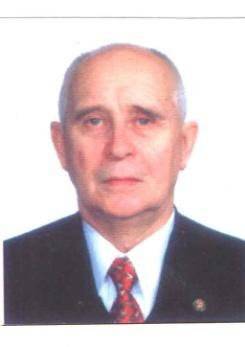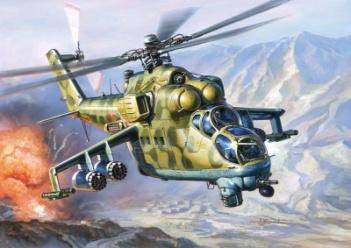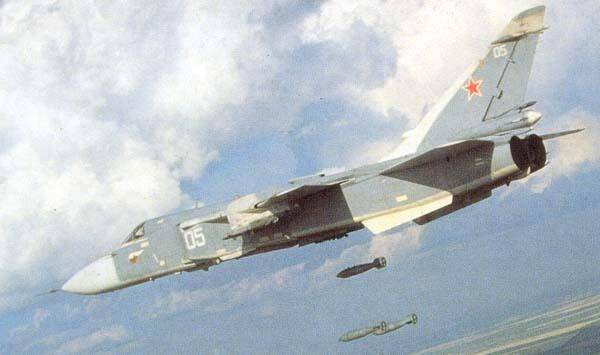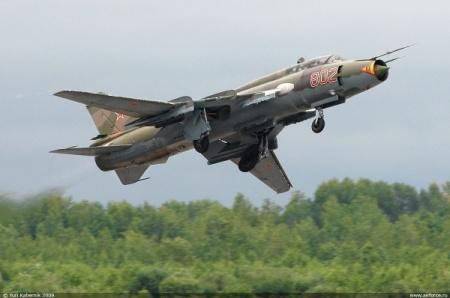The task is to increase the effectiveness of rocket-bomb strikes.
For mountainous areas with a rapid change in weather conditions, variable low cloud cover, worsening flight visibility, strong and gusty winds, delivering effective missile and bomb strikes was a great skill for pilots, not many managed to achieve this. Advanced combat missions aviation complicated due to: the inability to detect and recognize targets, restrictions on access to the attack zone, short aiming time, limited combat path and unpredictability when leaving an attack. These extreme conditions led to severe fatigue of even trained flight personnel, dulling vigilance and, in some cases, reckless actions. To carry out combat missions to support the ground units of the limited contingent of the Soviet Army, the flight crews of the front and army aviation, having received the mission and flight route, established contact with the advanced aircraft pilot as they approached the target. The designation of the front edge of their troops was carried out on the instructions of the gunner with smoke or a series of missiles of a prescribed color. Target designations were also carried out by the aircraft gunner on the radio, orienting the crew on typical ground objects, as well as firing rockets, tracer bullets, smoke shells in the direction of the enemy. Just as it was during the Great Patriotic War. The older generation remembers the story "Green Chains", which describes how fascist scouts at night directed bombers at the vital objects of Leningrad. But readers do not know that the special services of the Red Army quickly adopted the tactics of guiding fascist bombers and, using false signals, sent them to areas of the Gulf of Finland or to wastelands, where they dropped bombs. In this area of science, nothing has changed since then. All of the above actions are sometimes repeated by the enemy. Therefore, especially in the dark and in bad weather conditions, crews often could not distinguish their troops from enemy units, which in some cases led to the defeat of their units from missile and bomb attacks. Such flight accidents gave rise to crew caution in difficult conditions, as if conditions in Afghanistan could be simple. The analysis and proceedings of these flight accidents have always been at the highest level. Then the materials were transferred to the military prosecutor's office. Our Minister was always informed of such incidents in the army, and he understood that subordinate institutions should offer ways to solve this problem.
 After one of the Boards, the Minister asked me, together with the General Designer of the state identification system, to go to his office. The Ildus Shaikhulislamovich Institute was less busy than other scientific research institutes and design bureaus of the Main Department loaded with orders of the Ministry of Defense, so he decided to talk with us about the problem that had arisen in Afghanistan. The enterprises of the Main Directorate headed by me provided for the creation of navigation, landing and radar systems, precision time equipment, air traffic control systems, simulators for training a wide range of specialists, command radio lines, public identification systems, onboard avionics, etc. Therefore, the head of the Ministry knew who to entrust the training proposals before the Customer’s execution of technical assignments. After receiving instructions and asking a few questions, we asked for permission to leave for the Directorate, but Peter Stepanovich detained us and contacted A.N. Efimov and A.S. Systsov. He told them that Mostiukov and I were entrusted with preparing proposals for the creation of technical means that would prevent or reduce the likelihood of strikes by aviation in complex military units. Immediately by phone, the air forces were agreed upon - these were Major General V.I. and Major General Terkin E.V. On the part of Minaviaproma, the work was assigned to be coordinated by MP Simonov. With all the specified leaders, I.Sh. were personally acquainted.
After one of the Boards, the Minister asked me, together with the General Designer of the state identification system, to go to his office. The Ildus Shaikhulislamovich Institute was less busy than other scientific research institutes and design bureaus of the Main Department loaded with orders of the Ministry of Defense, so he decided to talk with us about the problem that had arisen in Afghanistan. The enterprises of the Main Directorate headed by me provided for the creation of navigation, landing and radar systems, precision time equipment, air traffic control systems, simulators for training a wide range of specialists, command radio lines, public identification systems, onboard avionics, etc. Therefore, the head of the Ministry knew who to entrust the training proposals before the Customer’s execution of technical assignments. After receiving instructions and asking a few questions, we asked for permission to leave for the Directorate, but Peter Stepanovich detained us and contacted A.N. Efimov and A.S. Systsov. He told them that Mostiukov and I were entrusted with preparing proposals for the creation of technical means that would prevent or reduce the likelihood of strikes by aviation in complex military units. Immediately by phone, the air forces were agreed upon - these were Major General V.I. and Major General Terkin E.V. On the part of Minaviaproma, the work was assigned to be coordinated by MP Simonov. With all the specified leaders, I.Sh. were personally acquainted.I asked Mostyukova I.Sh. in a week, come to Leningrad for the possibility of developing our proposals, which were to be reported to the Minister and with his approval to the Commander-in-Chief of the Air Force and the Minister of Aviation Industry. I held a meeting at the Leningrad Scientific Research Radio-Technical Institute (currently it is OJSC “RIRT”). When business leaders, PhDs, come together to find and propose a fundamental solution, and when these leaders are concerned with solving the tasks facing the industry, and even when the Minister himself set these tasks, the result is usually positive. It was suggested two options. The first was based on the use of interrogators and respondents of the system created by I.Sh. Mostyukov, the second on the integrated use of radionavigation systems created in scientific research institutes, headed by the directors Guzhva Yu.G. and Gromov G.N. As expected, they reported to the Minister, sent the materials to the Commander-in-Chief of the Air Force and the Minister of Aviation Industry. At the suggestion of Mostyukova I.Sh. Immediately began full-scale work directly in the areas of hostilities. The results were positive only for the designation of armored vehicles. When installing the defendants in the trenches and behind the boulders in the explosions of grenades and shells, they fell, the connection was broken. The designation of groupings was impossible to perform.

At the same time, to solve this problem, the on-board equipment Rhomb-1K (RSBN) and Skip (RSDN), Kvitok (RSDN) was integrated through the navigation systems. The onboard equipment was deployed on Su-24M and 2-x MI-24 helicopters (for testing). After the report to the Commander-in-Chief of the Air Force, generals E.V. Terkin. and Denisov V.I. prepared a directive of the General Staff of the Air Force on testing in the Baltic Military District at the test site in the area of the cities of Saldus and Mazeikiai. The work of the European chain of RSDN was taken under special control by the Center for Long-Range Radio Navigation of the Air Force. A group of specialists led by the head of the scientific research institute Guzhva Yu.G. and Deputy Head of the Bureau Mosyakovym EA as well as two heads of departments of relevant research institutes of the Ministry of Defense also arrived at the site. Previously, four vehicles were developed at the Moscow Compass design bureau, converted to receive signals from radio navigation systems and radio stations for communication. These cars were also delivered to the landfill in the Baltic States. According to its characteristics, the RSDN system determines the coordinates depending on the location of the object in the working area with an error 150-750 m. But the modeling carried out in Moscow Compass Design Bureau and the principle of “relative radio navigation” proposed by me allowed us to hope that the error in determining the coordinates of the object is out depending on the location in the work area will not exceed 5-7 meters. Airplanes, helicopters were housed at the airdrome in Saldus, flight crews and three onboard equipment specialists of RSBN and RSND were also stationed here. Rocket-bombing attacks were carried out on the 12 test site on 8 km in the area of the town of Mazeikiai, this is already in Lithuania. From the landfill, where the whole working group was located, including officers of the core research institutes of the Ministry of Defense, to the airfield in Saldus was about 45 km. After reviewing the pilots, and these were the front pilots who fought in Afghanistan, and the command of the test site with the task that was set before us by the directive of the Air Force General Staff, we proceeded to fix radio navigation points on the maps and terrain. The pilots and we at the test site used “kilometers” maps, specially delivered from the aviation headquarters of the Baltic Military District from Riga to the airfield and the commander of the test site. Upon arrival from Moscow to Riga, I talked with the head of the operational management of the headquarters. As I remember, the headquarters was located on Brivibas 55 Street. Introducing me to the location of the landfill and the airfield, the head of the operational department asked me to carefully work with griffed maps and to exclude a single appearance of specialists in the city. The situation and mood of the inhabitants of the Baltic republics became more intense in relation to the population of other regions of our country. Yes, there still began to be held perestroika activities. All this complicated the situation. Points on the maps indicated the conditional front edge of the defense, as well as the enemy's conditional points of support to be destroyed.

Here in the Baltics everything happened just like in the State Aircraft Research Institute of the Air Force in the Astrakhan Region during test flights. Then we, the chief designers, spent hours with the pilots on a test flight program. I learned how to do it, so the others only listened when the pilots were assigned the task. The practical work of aviation, given for testing the proposed principle of designation of the line of contact of troops, was given Tuesday and Thursday. The remaining days were intended for ground-based experiment and analysis of flight results. The European chain of RSDN worked around the clock, the pairing of the onboard equipment of the two radio navigation systems did not result in a single failure during all flights. The airplanes passed radio-navigation points designated for pilots at altitudes 100 and 5500 meters, the passage fixation was indicated by a light signal. Helicopters passed radio-navigation points introduced into the equipment at altitudes of the order of 10 meters. Having passed the point denoting the final zone of its territory, the helicopter gained 50 meters in height and hit the target at the point denoting the enemy's stronghold with cannons. The fixation of the passage of the point denoting its territory was recorded by resetting the pennants and the light signal. The accuracy of the passage of these points does not exceed 7 meters. The proposed method of marking the line of contact yielded positive results. You could complete the work and report the results.

The practical work of ground attack aircraft at this test site in the Baltic States with the use of bombs and airborne cannons was conducted around the clock (except Monday) on the days when we were engaged in ground preparation of experiments. On one of these flight days, when the attack aircraft practiced bombing from a strafing flight, I and Mosyakov E.A. crossed Lake Twenkinis, located in the area of the landfill, by boat. Su-17 attack aircraft at low altitude passed over the lake and hit targets set about two hundred meters from the shore. Guzhva Yu..G. stayed on the beach and with two officers to prepare a bath. When the attack aircraft began flying, our colleagues went to the small pier, adjacent to the bath, to observe the process of bombing. The lake was not wide, we already reached the middle of it, when another Su-17 passed over our heads. And then I saw one of the bombs off the plane, hit not the target, but exploded in the lake about 150 meters away from us. Apparently the pilot dropped it early. Our comrades were blown off the pier like a wind, and we calmly and Yevgeny Alexandrovich moored to him and went to the bathhouse. I asked everyone to forget about what happened and not to report anything to the head of the landfill. After all, we have completed the tests, we will leave, and the pilots need to learn and fly here.
In the Baltics, before these tests, I had to happen before. As a rule, I returned from Grodno from the Avtomagnitols factory to Moscow via Vilnius, and I checked the readiness of the airfield in Vilnius before handing over to Customers. It was a double-based airfield, well-equipped with radio complexes. But the 10 days spent in a relaxed atmosphere with talented specialists and combat pilots were special. I saw this edge with different eyes. Nowhere in our country, I have not seen how the inhabitants of the hamlets in the morning brought milk cans to the Saldus-Mazeikiai highway, and a state-owned truck, passing through, took them some time later. Nobody touched these cans except the driver of the sovkhoz machine. Often we saw storks in the fields, and deer in the forest on the range. They could admire and think about something, about their own. In the evenings I had with the officers, Guzhva Yu.G. and Mosiakov E.A. after working with the pilots of the next mission and the results of the flights return to the landfill. Three of our representatives remained at the airport for the possibility of making amendments to the on-board equipment, if necessary. We kept in touch with them over the radio. In order not to disturb the staff of the officer’s canteen at the training ground late in the evening, we sometimes dined in the same cafe on the highway. It worked around the clock, it was a private cafe. The small hall was always empty late in the evening, so we had dinner alone. The hostess with her husband gave us homemade delicious dishes. Dinner was held in a relaxed business environment, we did not talk about work, it was forbidden. Discussed usually news, theater repertoires and some films. But we still aroused the interest of the owners, they saw cars with Moscow numbers, antennas, and people in military uniform. Yet the owner of the cafe could not stand it and once asked why we came to them. They knew the local officers from the landfill well, because they had apartments in the city. I had to gossip and explain that we were working on the question of the possibility of making a movie in this place with the participation of foreign studios and artists. Therefore, we can prepare the material so that the owner and his wife will be invited to shoot. This ended the conversation and acquaintance.
The very same polygon under Mazeikyaynom appeared shortly after World War II. Here practiced shooting, bombing and landing. Therefore, residents of some farms were resettled and block posts were established to prevent the passage of unauthorized civilians to the areas of use. weapons. Driving along the roads of the landfill to the positions that we chose, or to the control point of the landfill, I looked at the abandoned houses and gardens with such pain. The head of the landfill, Colonel Spiridonov Ivan Zakharovich, a former pilot, forbade us to move alone even by car through the territory, we were always accompanied by a machine gunner. Thus while experts verified radio navigation points, the submachine gunner competently took a position for supervision and protection. After completing the work and saying goodbye to the head of the landfill, he said to me bitterly: “Apparently this is the last interesting work, Yuri Grigorievich, which you did here. We really liked your suggestions and results on improving aviation management. As a pilot I can confirm - you have achieved an increase in efficiency. It is a pity that we will not have to meet again, in a year they will ask us from here. Someone in the Government carried out serious work to separate the Baltic States from our country. It's a pity. After all, our people have invested so much money and energy into the development of this region. How many of our specialists have developed a farm here. Before us, the land was agricultural, and now highly qualified specialists are required everywhere. The Russians were sent here, settled down, started families, established their lives, and soon they would be abandoned without any support due to someone’s fault. ” The colonel was right. And so it happened, only a little earlier.
Some time later, a mobile chain of RSDN was deployed near Tashkent. To comply with the secrecy, it unfolded at night and under camouflage nets. This was carried out strictly according to instructions so that foreign intelligence did not record its introduction. I can only say that at the end of the Afghan war, attack aircraft from high altitude using the proposed method gave effective results in accuracy. About this were notes in foreign editions. Additionally, the method of targeting missiles from Mi-24 helicopters backlit by laser has become widely used. This method has already been worked out with the military in the army by the director of the ICB Compass, A.N. Zaitsev
It is surprising that the conduct of flight experiments and the beginning of the use of the principle of “relative navigation” in Soviet aviation for foreign special services came as a surprise. We are ahead of foreigners.
PS For readers, I can give an example from my scientific work, confirming the very careful observation of foreign intelligence services over the results of the creation of military hardware in our country. According to one of the developments after its adoption, I had to, as the chief designer, report at the Committee on State Prizes about the scientific value of this work. She nominated for State Prize. The chairman of the section, Colonel-General Pokrovsky Roman Petrovich and the members of the section knew me well and the positive aspects of the proposed work. However, the protocol message was supposed to do. When I was given the floor, and the members of the section revealed essays on this work, I asked for permission only to quote a review of our development published abroad, and not to make a report. Here's what was noted in the “WASHINGTON REPORT” 13 March 1979 year: “It’s a clear idea of the MiG-25 analysis. This release gives added credence to analysts' belief that the USSR tactics communications are more advanced than the systems now in the field. ”Here is the translation:“ The CIA reported that an analysis of the MIG-25 aircraft shows that this aircraft is capable of receiving information in the form of powerful short parcels, which complicates the work of the American system of suppression. This message once again confirms the opinion of experts that the tactical communication system in the USSR is more perfect than the American systems used in this field. ” Members of the section received a proposal - to accept work for voting. The USSR State Prize was awarded to the team of VNIIRA specialists. And the work of our system was fixed by American specials. services at Balkhash, when the Customer carried out major maneuvers.
At present, a message has appeared in the press (“Izvestia” of 6 of August 2013) that the Ministry of Defense of the Russian Federation is planning to install RSDN chains in Transbaikalia, in the Caucasus, the Far East and the Southern Urals. Together with the GLONASS system, all mobile objects of the Armed Forces of the Russian Federation will now be guaranteed to determine their coordinates when performing combat operations. I would very much like the RSDN chains to reappear along the coast of the Northern Sea Route. Once, under my leadership, the Mars-75 system was installed here - this is also the RSDN, only with a different signal format. The presence of such a system would protect our country from possible impacts of other states on the navigation support of moving objects. And also allowed more, and dictate the conditions for the wiring of foreign vessels along this path.
Information